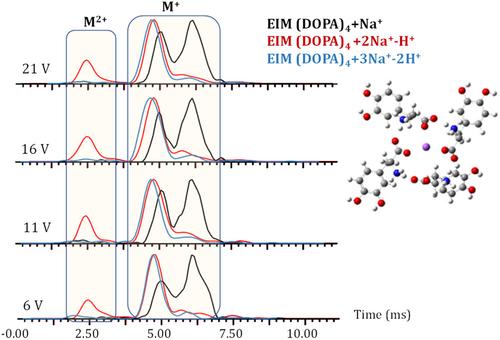下载PDF
{"title":"Mass spectrometry approaches to natural and synthetic melanin characterization","authors":"Addie R. Keating, Ali Dhinojwala, Chrys Wesdemiotis","doi":"10.1002/pi.6604","DOIUrl":null,"url":null,"abstract":"<p>Characterization of synthetic and natural melanin nanoparticles (MNPs) has been challenging due to the variability of properties and chemical bonding. Although eumelanin was the first to be discovered, four additional subcategories of melanin now exist including pheomelanin, neuromelanin, allomelanin and pyomelanin. Mass spectrometry (MS) methods have provided crucial insights into the bonding, structure, and mechanism regarding MNP formation, but inconsistent findings in the literature have caused further confusion in the analysis and structure of MNPs. This mini-review will focus on the types of MS experiments that have been used to analyze MNPs and what kind of information can be gained from different ionization sources, collisional activation experiments, and reaction monitoring quantitative methods when analyzing different subcategories of MNPs. Additionally, future directions regarding alternative applications of MNPs in MS experiments, mass defect analyses of complex mixtures, and a standardized nomenclature for isomeric redox states will all be addressed. © 2023 The Authors. <i>Polymer International</i> published by John Wiley & Sons Ltd on behalf of Society of Industrial Chemistry.</p>","PeriodicalId":20404,"journal":{"name":"Polymer International","volume":"73 4","pages":"253-260"},"PeriodicalIF":2.9000,"publicationDate":"2023-12-13","publicationTypes":"Journal Article","fieldsOfStudy":null,"isOpenAccess":false,"openAccessPdf":"https://onlinelibrary.wiley.com/doi/epdf/10.1002/pi.6604","citationCount":"0","resultStr":null,"platform":"Semanticscholar","paperid":null,"PeriodicalName":"Polymer International","FirstCategoryId":"92","ListUrlMain":"https://onlinelibrary.wiley.com/doi/10.1002/pi.6604","RegionNum":4,"RegionCategory":"化学","ArticlePicture":[],"TitleCN":null,"AbstractTextCN":null,"PMCID":null,"EPubDate":"","PubModel":"","JCR":"Q2","JCRName":"POLYMER SCIENCE","Score":null,"Total":0}
引用次数: 0
引用
批量引用
Abstract
Characterization of synthetic and natural melanin nanoparticles (MNPs) has been challenging due to the variability of properties and chemical bonding. Although eumelanin was the first to be discovered, four additional subcategories of melanin now exist including pheomelanin, neuromelanin, allomelanin and pyomelanin. Mass spectrometry (MS) methods have provided crucial insights into the bonding, structure, and mechanism regarding MNP formation, but inconsistent findings in the literature have caused further confusion in the analysis and structure of MNPs. This mini-review will focus on the types of MS experiments that have been used to analyze MNPs and what kind of information can be gained from different ionization sources, collisional activation experiments, and reaction monitoring quantitative methods when analyzing different subcategories of MNPs. Additionally, future directions regarding alternative applications of MNPs in MS experiments, mass defect analyses of complex mixtures, and a standardized nomenclature for isomeric redox states will all be addressed. © 2023 The Authors. Polymer International published by John Wiley & Sons Ltd on behalf of Society of Industrial Chemistry.
天然和合成黑色素表征的质谱分析方法
由于性质和化学键的可变性,合成和天然黑色素纳米颗粒(MNP)的表征一直具有挑战性。虽然真黑素是第一个被发现的,但现在又有四个子类别的黑色素存在,包括嗜黑素、神经黑素、嗜黑素和脓黑素。质谱(MS)方法为MNP形成的键合、结构和机制提供了重要的见解,但文献中不一致的发现导致了MNP分析和结构的进一步混乱。本文将重点介绍用于MNP分析的质谱实验类型,以及在分析MNP的不同子类时,从不同的电离源、碰撞激活实验和反应监测定量方法中可以获得什么样的信息。此外,MNP在质谱实验中的替代应用、复杂混合物的质量缺陷分析以及异构氧化还原态的标准化命名等未来方向都将得到解决。
本文章由计算机程序翻译,如有差异,请以英文原文为准。



